Introduction
The fiery skipper, Hylephila phyleus (Drury), is a common butterfly in the family Hesperiidae (Figure 1). Hylephila phyleus is widely distributed across the southern United States and Mexico, the Caribbean Islands, and lower elevations of South America to Argentina (Evans 1955; Opler and Krizek 1984; Stiles et al. 2003; Cech and Tudor 2005). Adults are often seen flying near flowers where they mate and feed on nectar, while the larvae are nocturnal (Shapiro and Manolis 2007). Commonly found near urban residences, fiery skipper larvae feed on various grasses, frequently preferring Bermudagrass (Cynodon dactylon) and very often using St. Augustinegrass (Stenotaphryum secundatum) (Minno et al. 2005).
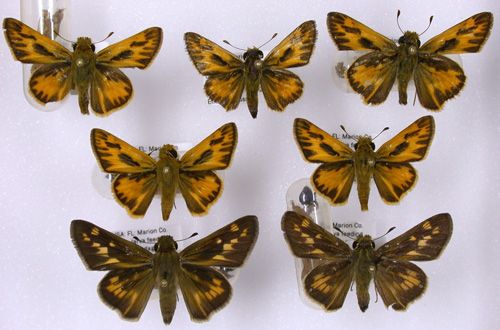
Credit: Lyle Buss, UF/IFAS
Distribution
Fiery skippers are common across most southern regions of the United States, and are resident as far south as Argentina (Evans 1955). Adults move north as the summer progresses (Stiles et al. 2003), and single individuals have been found as far north as New Brunswick, Canada (Clemens 2012). These vagrant individuals or ephemeral populations do not however persist through the winter (Stiles et al. 2003; Cech & Tudor 2005). Permanent populations of the fiery skipper in the US occur in areas surrounding the Gulf of Mexico, the desert southwest, and most of low-elevation California (Shapiro and Manolis 2007) and Hawaii (Tashiro and Mitchell 1985), where it is introduced and considered a pest. Fiery skippers are commonly found during the wet season, but occur during all months of the year within its permanent range. They are less often found in wildlands and favor turfgrass commonly grown for lawns in residential areas, such as Bermudagrass (Fernandez-Hernandez 2007).
Life Cycle
Eggs
When first laid, eggs appear white and pearlescent, but develop a blue hue after a couple of days. On average, eggs have a diameter of 0.75 mm and a height of 0.52 mm. Eggs are laid individually, usually under the leaf blades or on the stems of their host plant (Tashiro and Mitchell 1985).
Larva
In the first instars, larvae appear green before transitioning to the darker brown that is common in the later instar larvae (Figure 2). As a first instar, their length ranges from 2.0 mm to 3.9 mm and increases to 17.9 mm to 29.9 mm by the fifth instar. The head capsule width of the first instar larvae ranges from 0.4 mm to 0.5 mm, with fifth instars ranging from 2.7 mm to 3.0 mm. Most prominent in all larval instars is a large, black, constricted segment behind the head capsule (Tashiro and Mitchell 1985). Larvae begin to spin silk during the third instar as they near pupation (Tashiro and Mitchell 1985). After 16 days, the larvae pupate, and emerge seven to ten days later as adults.
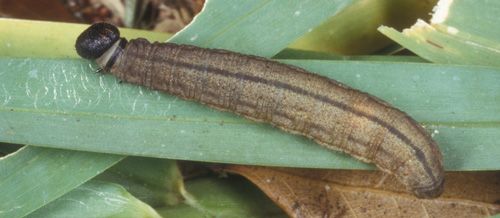
Credit: Lyle J. Buss, UF/IFAS
Pupa
Pupae are yellow-green before maturing into a brown color. Nearing eclosion (the emergence of an adult insect from a pupal case or an insect larva from an egg), the coloration of the adult's forewings is visible and sex can be determined. Pupation usually occurs under a shelter that consists of a simple cocoon made of the host plant and silk; however, pupal development will occur without a cocoon if the availability of plant material is limited (Tashiro and Mitchell 1985).
Adult
Both sexes of fiery skipper adults have short, knobbed antennae and orange and brown patterned wings. Females can be differentiated from males by the greater number and larger size of brown patches on both the top and underside of the wings (Figure 3). On the edges of the male's wings are black marginal markings giving the wing edges a toothed appearance (Brock and Kaufman 2006) (Figure 4). Overall, their wingspan is around 3.0 to 4.0 cm (1.18 in to 1.57 in) (Deputy and Hara 2000). Adults in the desert southwest and California tend to be lighter in color, especially near Death Valley, California (Scott 1986). Adults mate the day they emerge and females lay eggs three to four days after mating. Females deposit 50 to 150 eggs (Deputy and Hara 2000) on the underside of grass blades and stems (Tashiro and Mitchell 1985).
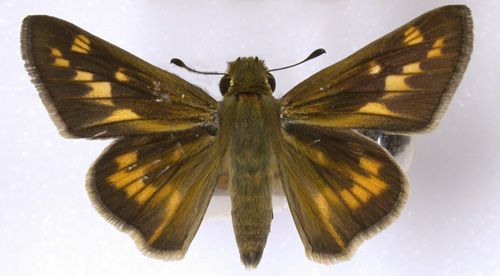
Credit: Lyle J. Buss, UF/IFAS
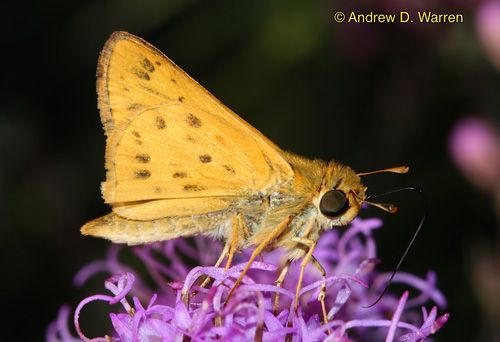
Credit: Andrew D. Warren, UF Florida Museum of Natural History
Behavior
Larvae are most abundant in grasses near flower garden beds, because the adults feed on the nectar of the flowers and lay their eggs near this adult food source (Deputy and Hara 2000). Like other skippers, the larvae not only feed on the leaves of their host plant (Figure 5), but also roll the leaves into shelters (Triplehorn and Johnson 2005). Leaf shelters are built to lie lengthwise under grass blades (Scott 1986). Larvae remain inactive in these shelters until nightfall (Tashiro and Mitchell 1985). After the third instar, larvae begin to spin silk profusely as the time to pupate nears (Tashiro and Mitchell 1985). Pupae overwinter in leaf shelters. They cannot overwinter in regions with harsh winters.
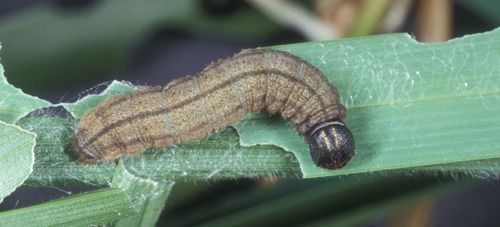
Credit: Lyle J. Buss, UF/IFAS
Adult fiery skippers exhibit the erratic skipping flight typical of their family, Hesperiidae (Deputy and Hara 2000). Females (Figure 6) actively search for suitable habitats after emergence, males perch to wait for potential mates (Triplehorn and Johnson 2005; Scott 1986). In a study on mating behavior by Shapiro (1975), females were found to have traveled an average of 37 meters (40.46 yards) per day, with males traveling an average of 30 meters (32.8 yards) per day. In addition, the study by Shapiro suggests most dispersal occurs immediately after emergence.
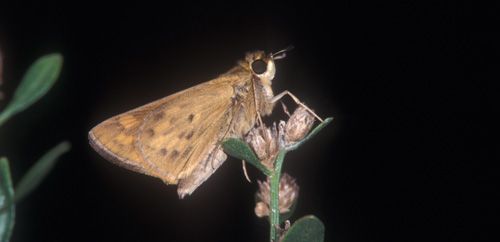
Credit: Lyle J. Buss, UF/IFAS
Host Plants
Adults visit a wide variety of flowers, but the host plants of larvae are of greater interest due to the larval feeding damage on the leaves.
Larvae have been known to feed on Cynodon dactylon (Bermudagrass), Paspalum sp. (dallisgrass), Stenotaphrum secundatum (St. Augustinegrass), Digitaria sanguinalis (hairy crabgrass), Agrostis sp. (bentgrass), Eragrostis hypnoides (teal lovegrass), Poa pratensis (Kentucky bluegrass), Saccharum officinarum (sugarcane), and Axponopus compressus (broadleaf carpetgrass) (Scott 1986).
Adults have been known to visit the following flowers: Bidens pilosa (hairy beggarticks), Blechum pyramidatum (Browne's blechum), Cestrum diurnum (day jessamine), Chromolaena odorata (blue mistflower), Citrus sp., Kallstroemia maxima (big caltrop), Macroptilium atropurpureum (siratro), Portulaca oleracea (little hogweed), and Tournefortia hirsutissima (chiggery grapes) (Fernandez-Hernandez 2007), although likely will use almost any nectar source.
Management
The fiery skipper is not usually considered a pest species within its native range, although in Hawaii where it has been introduced it has been reported as a turfgrass pest. As larvae reside in the covering of grasses, removing debris, like lawn clippings, limits their habitat and is an effective method of control (Deputy and Hara 2000). Only remove clippings if you believe there is an infestation requiring treatment. However, if the situation requires more aggressive measures biological methods of control, such as Bacillus thuringiensis (Bt), parasitic nematodes, and wasps of families Ichneumonidae and Braconidae, can be used (Southerland et al. 2009).
Selected References
Brock JP, Kaufman K. 2006. Field Guide to Butterflies of North America. Houghton Mifflin Co., New York. 392 pp.
Cech R, Tudor G. 2005. Butterflies of the East Coast. An Observer's Guide. Princeton University Press. 345 pp.
Clements J. 2012. First record of the fiery skipper, Hylephila phyleus Drury (Lepidoptera: Hesperiidae) from New Brunswick, Canada. Journal of the Acadian Entomological Society 8 59–60.
Deputy J, Hara A. 2000. Destructive turf caterpillars in Hawaii. College of Tropical Agriculture and Human Resources. Insect Pests 5: 8–9.
Evans WH. 1955. A Catalogue of the American Hesperiidae indicating the classification and nomenclature adopted in the British Museum (Natural History). Part IV. Hesperiinae and Megathyminae. London, British Museum. 499 pp. + pls. 54–88.
Fernandez-Hernandez D. 2007. Butterflies of the agricultural experiment station of tropical roots and tubers, Santa Ana, and Camagüey, Cuba: An annotated list. Acta Zoologica Mexicana 23: 43–75.
Opler PA, Krizek G. 1984. Butterflies East of the Great Plains. Johns Hopkins Univ. Press, Baltimore. xvii + 249 pp.
Scott J. 1986. The Butterflies of North America. Stanford University Press. p. 434.
Shapiro, I. 1975. Courtship and mating behavior of the fiery skipper, Hylephila phylaeus [sic] (Hesperiidae). Journal of Research on the Lepidoptera 14:125–141.
Shapiro A, Manolis T. 2007. Butterflies of the San Francisco Bay and Sacramento Valley Regions. University of California Press, Berkeley, CA p. 236-237.
Stiles G, Holy M, Weber PG. 2003. The fiery skipper (Hylephila phyleus Drury) in north central New York. News of the Lepidopterists' Society 45:3–4, 7.
Sutherland AM, Flint ML, Harivandi MA. 2009. UC IPM Pest Management Guidelines: Turfgrass. University of California Agriculture and Natural Resources Statewide Integrated Pest Management Program, UC ANR Publication 3365-T (20 April 2021)
Tashiro H, Mitchell WC. 1985. Biology of the fiery skipper, Hylephila phyleus (Lepidoptera: Hesperiidae), a turfgrass pest in Hawaii. Proceedings of the Hawaiian Entomological Society 25: 131–138.
Triplehorn CA, Johnson NF. 2005. Borror and Delong's Introduction to the Study of Insects. Thomson Brooks/Cole, Belmont, CA. p. 619.